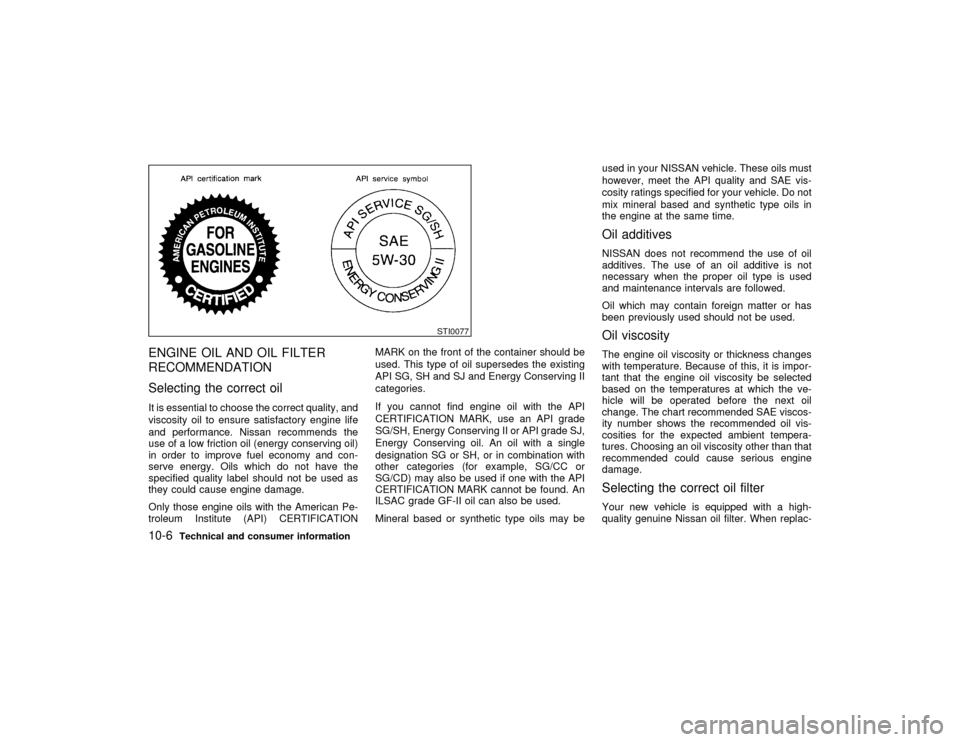fuel filter NISSAN PATHFINDER 1999 R50 / 2.G Owners Manual
[x] Cancel search | Manufacturer: NISSAN, Model Year: 1999, Model line: PATHFINDER, Model: NISSAN PATHFINDER 1999 R50 / 2.GPages: 274, PDF Size: 2.34 MB
Page 201 of 274

When performing any inspection or mainte-
nance work on your vehicle, always take care
to prevent serious accidental injury to yourself
or damage to the vehicle. The following are
general precautions which should be closely
observed.IPark the vehicle on a level surface,
apply the parking brake securely and
block the wheels to prevent the ve-
hicle from moving. For a manual
transmission, move the shift lever to
Neutral. For an automatic transmis-
sion, move the selector lever to P
(Park).
IBe sure the ignition key is in the OFF
or LOCK position when performing
any replacement or repair.
IIf you must work with the engine
running, keep your hands, clothing,
hair and tools away from moving fans
and fan belts.
IIt is advisable to remove necktie and
any jewelry, such as rings, watches,
etc. before working on your vehicle.IAlways wear eye protection when-
ever you work on your vehicle.
IIf you must run the engine in an
enclosed space such as a garage, be
sure there is proper ventilation for
exhaust gases.
INever get under the vehicle while it is
supported only by a jack. If it is nec-
essary to work under the vehicle,
support it with safety stands.
IKeep smoking materials, flame and
sparks away from fuel and battery.
IThe fuel filter or fuel lines should be
serviced by a NISSAN dealer because
the fuel lines are under high pressure
even when the engine is off.
IDo not work under the engine hood
while it is hot. Always turn off the
engine and wait until it cools down.
INever connect or disconnect either
the battery or any transistorized com-ponent connector while the ignition
key is on.
IAvoid direct contact with used engine
oil. Improperly disposed motor oil and/
or other vehicle fluids can hurt the
environment. Always conform to lo-
cal regulations for disposal of vehicle
fluid.
This ª8. Do-it-yourselfº section gives instruc-
tions regarding only those items which are
relatively easy for an owner to perform.
You should be aware that incomplete or im-
proper servicing may result in operating diffi-
culties or excessive emissions, and could af-
fect your warranty coverage.If in doubt about
any servicing, have it done by your NISSAN
dealer.
MAINTENANCE PRECAUTIONS8-2
Do-it-yourself
Z
01.1.22/R50-D/V5
X
Page 207 of 274

CHANGING ENGINE OIL1. Park the vehicle on a level surface and
apply the parking brake.
2. Warm up the engine until it reaches oper-
ating temperature, and then turn it off.
3. Place a large drain pan under the drain
plug.
4. Remove the oil filler cap.
5. Remove the drain plug with a wrench and
completely drain the oil.
If the oil filter is to be changed, remove and
replace it at this time. See later in thissection for changing engine oil filter.
Be careful not to burn yourself, as the
engine oil is hot.Waste oil must be disposed of properly.
Check your local regulations.
6. Clean and re-install the drain plug and new
washer. Securely tighten the drain plug with
a wrench. Do not use excessive force.
Drain plug tightening torque:
22 to 29 ft-lb (29 to 39 N×m)
7. Refill engine with recommended oil through
the oil filler opening, then install the oil filler
cap securely.
See ªCapacities and recommended
fuel/lubricantsº in the ª10. Technical and
consumer informationº section for drain and
refill capacity.
The drain and refill capacity depends on the
oil temperature and drain time. Use these
specifications for reference only. Always
use the dipstick to determine when the
proper amount of oil is in the engine.8. Start the engine.
Check for leakage around the drain plug.
Correct as required.
9. Turn the engine off and wait several min-
utes. Check the oil level with the dipstick.
Add engine oil if necessary.
IProlonged and repeated contact with
used engine oil may cause skin can-
cer.
ITry to avoid direct skin contact with
used oil. If skin contact is made, wash
thoroughly with soap or hand cleaner
as soon as possible.
IKeep used engine oil out of reach of
children.
SDI0416
8-8
Do-it-yourself
Z
01.1.22/R50-D/V5
X
Page 238 of 274
![NISSAN PATHFINDER 1999 R50 / 2.G Owners Manual Schedule 1Abbreviations: R = Replace I = Inspect. Correct or replace if necessary. [ ]: At the mileage intervals onlyMAINTENANCE OPERATIONMAINTENANCE INTERVAL
Perform at number of miles, kilometers or NISSAN PATHFINDER 1999 R50 / 2.G Owners Manual Schedule 1Abbreviations: R = Replace I = Inspect. Correct or replace if necessary. [ ]: At the mileage intervals onlyMAINTENANCE OPERATIONMAINTENANCE INTERVAL
Perform at number of miles, kilometers or](/img/5/634/w960_634-237.png)
Schedule 1Abbreviations: R = Replace I = Inspect. Correct or replace if necessary. [ ]: At the mileage intervals onlyMAINTENANCE OPERATIONMAINTENANCE INTERVAL
Perform at number of miles, kilometers or
months, whichever comes first.Miles´1,000 3.75 7.5 11.25 15 18.75 22.5 26.25 30 33.75 37.5 41.25 45 48.75 52.5 56.25 60
(km´1,000) (6) (12) (18) (24) (30) (36) (42) (48) (54) (60) (66) (72) (78) (84) (90) (96)
Months 3 6 9 12 15 18 21 24 27 30 33 36 39 42 45 48
Emission control system maintenance
Drive beltsI* I*
Air cleaner filter See NOTE (1) [R] [R]
EVAP vapor linesI* I*
Fuel linesI* I*
Fuel filter See NOTE (2)*
Engine coolant See NOTE (3)R*
Engine oilRRRRRRRRRRRRRRRR
Engine oil filter
(Use Part No. 15208 31U00 or equivalent.)RRRRRRRRRRRRRRRR
Spark plugs (PLATINUM-TIPPED type)[R]
Timing beltReplace every 105,000 miles (168,000 km)NOTE: (1) If operating mainly in dusty conditions, more frequent maintenance may be required.
(2) If vehicle is operated under extremely adverse weather conditions or in areas where ambient temperatures are either extremely low or
extremely high, the filters might become clogged. In such an event, replace them immediately.
(3) After 60,000 miles (96,000 km) or 48 months, replace every 30,000 miles (48,000 km) or 24 months.
HMaintenance items and intervals with ª*º are recommended by NISSAN for reliable vehicle operation. The owner need not perform such
maintenance in order to maintain the emission warranty or manufacturer recall liability. Other maintenance items and intervals are required.
Maintenance
9-7
Z
01.1.22/R50-D/V5
X
Page 240 of 274
![NISSAN PATHFINDER 1999 R50 / 2.G Owners Manual Schedule 2Abbreviations: R = Replace I = Inspect. Correct or replace if necessary. [ ]: At the mileage intervals onlyMAINTENANCE OPERATIONMAINTENANCE INTERVAL
Perform at number of miles, kilometers or NISSAN PATHFINDER 1999 R50 / 2.G Owners Manual Schedule 2Abbreviations: R = Replace I = Inspect. Correct or replace if necessary. [ ]: At the mileage intervals onlyMAINTENANCE OPERATIONMAINTENANCE INTERVAL
Perform at number of miles, kilometers or](/img/5/634/w960_634-239.png)
Schedule 2Abbreviations: R = Replace I = Inspect. Correct or replace if necessary. [ ]: At the mileage intervals onlyMAINTENANCE OPERATIONMAINTENANCE INTERVAL
Perform at number of miles, kilometers or
months, whichever comes first.Miles´1,000 7.5 15 22.5 30 37.5 45 52.5 60
(km´1,000) (12) (24) (36) (48) (60) (72) (84) (96)
Months 6 12 18 24 30 36 42 48
Emission control system maintenance
Drive beltsI* I*
Air cleaner filter[R] [R]
EVAP vapor linesI* I*
Fuel linesI* I*
Fuel filter See NOTE (1)*
Engine coolant See NOTE (2)R*
Engine oilRRRRRRRR
Engine oil filter (Use Part No. 15208 31U00 or equivalent.)RRRRRRRR
Spark plugs (PLATINUM-TIPPED type)[R]
Timing beltReplace every 105,000 miles (168,000 km)
NOTE: (1) If vehicle is operated under extremely adverse weather conditions or in areas where ambient temperatures are either extremely low or
extremely high, the filters might become clogged. In such an event, replace them immediately.
(2) After 60,000 miles (96,000 km) or 48 months, replace every 30,000 miles (48,000 km) or 24 months.
HMaintenance items and intervals with ª*º are recommended by NISSAN for reliable vehicle operation. The owner need not perform such
maintenance in order to maintain the emission warranty or manufacturer recall liability. Other maintenance items and intervals are required.
Maintenance
9-9
Z
01.1.22/R50-D/V5
X
Page 242 of 274

Emission control system
maintenanceAdditional information on the following
items with * is found in the ª8. Do-it-
yourselfº section.
Drive belts*:
Check drive belts for wear, fraying or cracking
and also for proper tension. Replace the drive
belts if found damaged.
Air filter:
Under normal driving conditions, the air
cleaner filter should be replaced in accordance
with the maintenance schedule. However,
driving the vehicle in dusty areas may cause
more rapid clogging of the element. Conse-
quently, the element may have to be replaced
more frequently.
EVAP vapor lines:
Check vapor lines and connections for failure
or looseness. If leaks are found, replace the
lines.
Fuel lines:
Check the fuel hoses, piping and connections
for leaks, looseness or deterioration. Replace
any parts if they are damaged.Fuel filter:
If the vehicle is operated under extremely
adverse weather conditions or in areas where
ambient temperatures are either extremely low
or extremely high, the filter might become
clogged. In such an event, replace the filter
immediately.
Engine coolant*:
Flush and refill the cooling system.
Engine oil & oil filter*:
Under normal driving conditions, the engine oil
and oil filter should be replaced in accordance
with the maintenance schedule. However, un-
der severe driving conditions, they may have
to be replaced more frequently.
Spark plugs*:
Replace with new plugs having the correct
heat range.
Timing belt:
Replace the timing belt for driving the cam-
shafts.
Chassis and body maintenanceBrake lines & cables:
Check the brake lines and hoses (including
brake booster vacuum hoses, connections &
check valve) and parking brake cables for
proper attachment, leaks, cracks, chafing,
abrasion, deterioration, etc.
Brake pads, rotors, drums & linings:
Check these and the other neighboring brake
components for wear, deterioration and leaks.
Under severe driving conditions, they may
have to be inspected more frequently.
Manual and automatic transmission,
transfer & differential gear fluid:
Visually inspect for signs of leakage and re-
place oil for limited-slip differential. Under se-
vere driving conditions, the oil should be re-
placed at the specified interval.
Steering gear, linkage & transfer gear,
axle & suspension parts & drive axle
shaft boots:
Check for damage, looseness and leakage of
oil or grease. Under severe driving conditions,
more frequent inspection should be per-
formed.
Maintenance
9-11
Z
01.1.22/R50-D/V5
X
Page 244 of 274

10 Technical and consumer informationCapacities and recommended fuel/lubricants ......... 10-2
Fuel recommendation ............................................. 10-4
Engine oil and oil filter recommendation................. 10-6
Recommended SAE oil viscosity number ............... 10-7
Air conditioning system refrigerant and lubricant
recommendations .................................................... 10-8
Specifications .......................................................... 10-9
Engine ..................................................................... 10-9
Tires and wheels ................................................... 10-10
Dimensions and weights ....................................... 10-10
When traveling or registering your vehicle in another
country................................................................... 10-11
Vehicle identification ............................................. 10-11
Vehicle identification number (VIN) plate.............. 10-11
Vehicle identification number (Chassis number) .. 10-11
Engine serial number ............................................ 10-12F.M.V.S.S. certification label ................................. 10-12
Emission control information label ........................ 10-12
Tire placard ........................................................... 10-13
Air conditioner specification label.......................... 10-13
Vehicle loading information ................................... 10-13
Terms .................................................................... 10-13
Determining vehicle load capacity ........................ 10-14
Loading tips ........................................................... 10-14
Towing a trailer ..................................................... 10-15
Maximum load limits.............................................. 10-15
Towing load/specification chart ............................. 10-16
Towing safety ........................................................ 10-17
Emission control system warranty ........................ 10-18
Reporting safety defects (US only) ....................... 10-19
Readiness for inspection/maintenance (I/M) test (US
only)....................................................................... 10-19
Z
01.1.22/R50-D/V5
X
Page 245 of 274

The following values are approximate capacities. The actual refill capacities may be a little different from them. When refilling, follow the
procedure instructed in the ª8. Do-it-yourselfº section to determine the proper refill capacity.
Capacity (Approximate)
Recommended specifications
US
measureImp
measureLiter
Fuel 21-1/8 gal 17-5/8 gal 80Unleaded gasoline with an octane rating
of at least 87 AKI (RON 91)*1
Engine oil*4
Drain and refill
with oil filter
change3-7/8 qt 3-1/4 qt 3.7IAPI Certification Mark*2 *3
IAPI grade SG/SH, Energy Conserving II
or API grade SJ, Energy Conserving*2
*3
IILSAC grade GF-II*2 *3 without oil filter
change3-5/8 qt 3 qt 3.4
Cooling system
(with heater and
reservoir tank)11-1/4 qt 9-3/8 qt 10.6Genuine Nissan Anti-Freeze Coolant or
equivalent
(Ethylene glycol base 50% demineralized
water or distilled water)
*1: See later in this section for fuel recommendation.
*2: See later in this section for recommended SAE viscosity number.
*3: See later in this section for engine oil and oil filter recommendation.
*4: See ªChanging engine oilº in the ª8. Do-it-yourselfº section for further details.CAPACITIES AND
RECOMMENDED
FUEL/LUBRICANTS10-2
Technical and consumer information
Z
01.1.22/R50-D/V5
X
Page 249 of 274

ENGINE OIL AND OIL FILTER
RECOMMENDATION
Selecting the correct oilIt is essential to choose the correct quality, and
viscosity oil to ensure satisfactory engine life
and performance. Nissan recommends the
use of a low friction oil (energy conserving oil)
in order to improve fuel economy and con-
serve energy. Oils which do not have the
specified quality label should not be used as
they could cause engine damage.
Only those engine oils with the American Pe-
troleum Institute (API) CERTIFICATIONMARK on the front of the container should be
used. This type of oil supersedes the existing
API SG, SH and SJ and Energy Conserving II
categories.
If you cannot find engine oil with the API
CERTIFICATION MARK, use an API grade
SG/SH, Energy Conserving II or API grade SJ,
Energy Conserving oil. An oil with a single
designation SG or SH, or in combination with
other categories (for example, SG/CC or
SG/CD) may also be used if one with the API
CERTIFICATION MARK cannot be found. An
ILSAC grade GF-II oil can also be used.
Mineral based or synthetic type oils may beused in your NISSAN vehicle. These oils must
however, meet the API quality and SAE vis-
cosity ratings specified for your vehicle. Do not
mix mineral based and synthetic type oils in
the engine at the same time.
Oil additivesNISSAN does not recommend the use of oil
additives. The use of an oil additive is not
necessary when the proper oil type is used
and maintenance intervals are followed.
Oil which may contain foreign matter or has
been previously used should not be used.Oil viscosityThe engine oil viscosity or thickness changes
with temperature. Because of this, it is impor-
tant that the engine oil viscosity be selected
based on the temperatures at which the ve-
hicle will be operated before the next oil
change. The chart recommended SAE viscos-
ity number shows the recommended oil vis-
cosities for the expected ambient tempera-
tures. Choosing an oil viscosity other than that
recommended could cause serious engine
damage.Selecting the correct oil filterYour new vehicle is equipped with a high-
quality genuine Nissan oil filter. When replac-
STI0077
10-6
Technical and consumer information
Z
01.1.22/R50-D/V5
X
Page 266 of 274

11 Index
A
ABS (Anti-lock brake system) ......................... 5-25
Air bag
Warning labels........................................... 1-20
Warning light .................................... 1-20, 2-10
Air bag system (See supplemental restraint
system) ........................................................... 1-16
Air bag system, side (See supplemental side air
bag system) .................................................... 1-10
Air cleaner housing filter ................................. 8-16
Air conditioner
Air conditioner operation ...................... 4-3, 4-9
Air conditioner service ................ 4-3, 4-9, 4-11
Air conditioner specification
label .......................................... 4-3, 4-9, 10-13
Air conditioner system refrigerant and
lubrication recommendations ............... 4-3, 4-9
Heater and air conditioner (automatic) (if so
equipped)..................................................... 4-9
Heater and air conditioner controls ............. 4-3
Servicing air conditioner .............................. 4-3
Air conditioning system refrigerant and lubricant
recommendations ........................................... 10-8
Air flow charts ............................................ 4-6, 4-9
Alcohol drugs and driving ................................. 5-4
AM-FM radio with cassette player .................. 4-12
AM-FM radio with cassette player and compact
disc player....................................................... 4-12
AM-FM radio with compact disc player .......... 4-12Anchor point locations
Top tether strap ......................................... 1-40
Antenna
Manual ....................................................... 4-25
Power ........................................................ 4-25
Anti-lock Brake System (ABS) ........................ 5-25
Anti-lock brake warning light........................... 2-11
Appearance care
Exterior appearance care ............................ 7-2
Interior appearance care ............................. 7-3
Armrest ............................................................. 1-9
Ashtray (See cigarette lighter and ashtray) .... 2-25
Audio system .................................................. 4-12
Automatic
Automatic transmission fluid (ATF) ............. 8-9
Sunroof ...................................................... 2-34
Avoiding collision and rollover .......................... 5-4
B
Battery............................................................. 8-13
Battery replacement, (See multi-remote control
system) ............................................................. 3-8
Before starting the engine ................................ 5-8
Belts (See drive belts) .................................... 8-14
Brake
Anti-lock brake system (ABS) ................... 5-25
Brake and clutch fluid................................ 8-11
Brake booster ............................................ 8-19
Brake fluid ................................................. 8-11Brake pedal ............................................... 8-18
Brake pedal check..................................... 8-19
Parking brake check ........................ 5-15, 8-18
Parking brake operation ............................ 5-15
System....................................................... 5-25
Warning light ............................................. 2-11
Break-in schedule ........................................... 5-18
Bulb check/instrument panel ............................ 2-9
Bulb replacement ............................................ 8-22
C
Capacities and recommended
fuel/lubricants .................................................. 10-2
Car phone ....................................................... 4-26
Cassette player (See audio system) .............. 4-16
Cassette tape operation ................................. 4-12
Catalytic converter, Three way catalyst............ 5-3
CB radio or car phone .................................... 4-26
Cellular phone
Steering switch .......................................... 2-50
Switch operation ........................................ 2-51
Child restraints ................................................ 1-31
Installation on front passenger seat .......... 1-41
Installation on rear seat outboard
positions .................................................... 1-35
Installation on rear seat center position .... 1-32
Precautions on child restraints .................. 1-31
Top tether strap anchor point locations .... 1-40
With top tether strap.................................. 1-40
Z
01.1.22/R50-D/V5
X
Page 267 of 274

Child safety ..................................................... 1-24
Child safety rear door lock................................ 3-4
Chimes ............................................................ 2-14
Cigarette lighter (accessory) and ashtray....... 2-25
Circuit breaker, Fusible link ............................ 8-21
Cleaning exterior and interior ........................... 7-3
Clutch
Clutch pedal .............................................. 8-20
Fluid ........................................................... 8-11
Cold weather driving ....................................... 5-27
Compact Disc (CD) player (See audio
system) ........................................................... 4-23
Compact disc (CD) player operation .............. 4-12
Compass display .............................................. 2-7
Console box .................................................... 2-28
Controls
Audio controls............................................ 4-12
Audio controls (rear).................................. 4-12
Audio controls (steering wheel)................. 4-12
Heater and air conditioner controls ............. 4-3
Heater and air conditioner controls
(automatic)................................................... 4-9
Coolant
Capacities and recommended fuel/
lubricants ................................................... 10-2
Changing engine coolant ............................ 8-5
Checking engine coolant level .................... 8-4
Corrosion protection ......................................... 7-4
Cruise control.................................................. 5-16
Cup holders .................................................... 2-26
DDaytime running light system ......................... 2-20Defogger switch, Glass hatch and outside mirror
defogger switch............................................... 2-18
Dimensions and weights ............................... 10-10
Door ajar warning light.................................... 2-10
Drive belts ....................................................... 8-14
Driving
Cold weather driving ................................. 5-27
Driving with manual transmission ............. 5-13
On-pavement and offroad driving ............... 5-3
Precautions when starting and driving ........ 5-2
E
Economy, Fuel ................................................ 5-19
Emission control information label ................ 10-12
Emission control system warranty ................ 10-18
Engine
Before starting the engine ........................... 5-8
Block heater .............................................. 5-28
Capacities and recommended fuel/
lubricants ................................................... 10-2
Changing engine coolant ............................ 8-5
Changing engine oil .................................... 8-8
Changing engine oil filter ............................ 8-9
Checking engine coolant ............................. 8-4
Checking engine oil level ............................ 8-7
Coolant temperature gauge ........................ 2-4
Engine compartment check locations ......... 8-3
Engine cooling system ................................ 8-4
Engine oil..................................................... 8-7
Engine oil and oil filter recommendation... 10-6
Engine oil viscosity .................................... 10-6
Engine serial number .............................. 10-12
Engine specifications................................. 10-9If your engine overheats ........................... 6-10
Starting the engine ...................................... 5-8
Exhaust gas (Carbon monoxide) ...................... 5-2
F
F.M.V.S.S. certification label......................... 10-12
Filter, Air cleaner housing filter ....................... 8-16
Flashers (See hazard warning flasher
switch) ............................................................. 2-22
Flat tire .............................................................. 6-2
Floor mat cleaning ............................................ 7-4
Fluid
Automatic transmission fluid (ATF) ............. 8-9
Brake and clutch fluid................................ 8-11
Brake fluid ................................................. 8-11
Capacities and recommended fuel/
lubricants ................................................... 10-2
Engine coolant............................................. 8-4
Engine oil..................................................... 8-7
Power steering fluid................................... 8-11
Window washer fluid ................................. 8-12
Fog light switch ............................................... 2-22
Four wheel drive (4WD).................................. 5-19
Front manual seat adjustment .......................... 1-2
Fuel
Capacities and recommended fuel/
lubricants ................................................... 10-2
Filler cap .................................................... 3-13
Filler lid ...................................................... 3-12
Filler lid and cap ........................................ 3-12
Filler lid opener lever................................. 3-12
Fuel economy ............................................ 5-19
Fuel octane rating ..................................... 10-4
Z
01.1.22/R50-D/V5
X
11-2